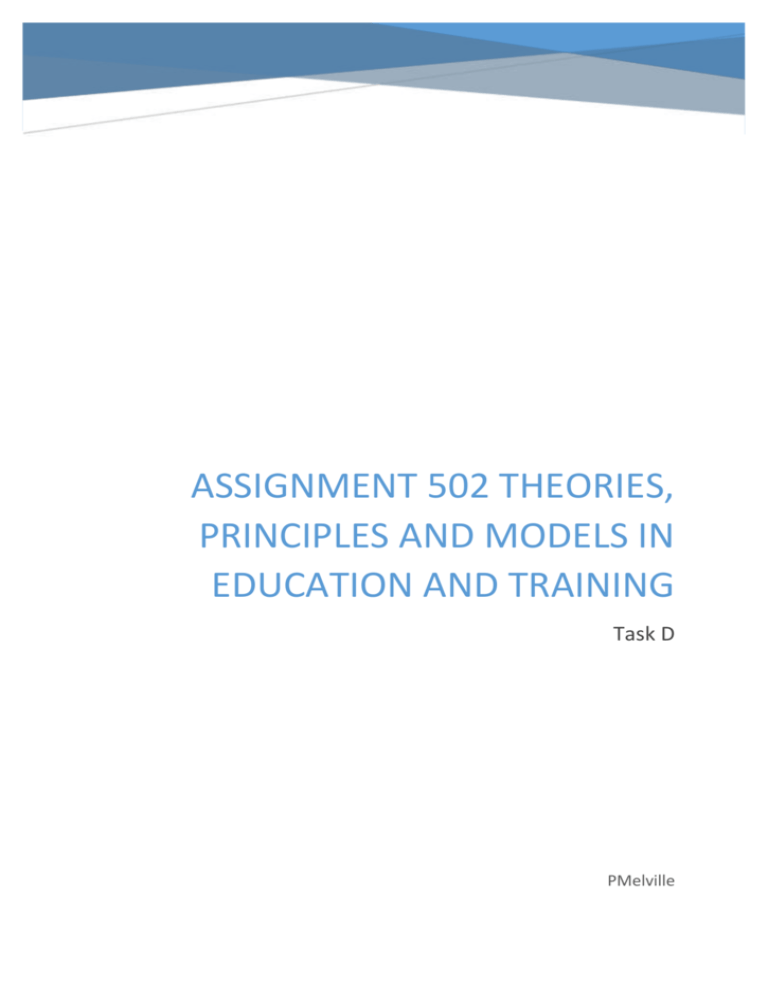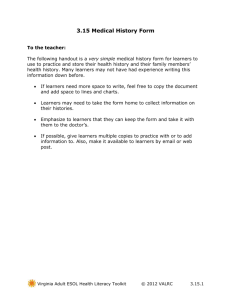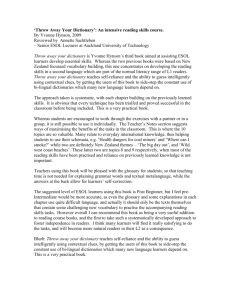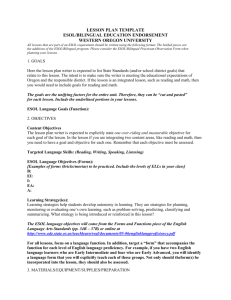Assignment 502 Theories, principles and models in education and
advertisement

ASSIGNMENT 502 THEORIES, PRINCIPLES AND MODELS IN EDUCATION AND TRAINING Task D PMelville Table of Contents Introduction ............................................................................................................................................ 2 1. Theories and models of curriculum development .......................................................................... 2 How do we define curriculum? ........................................................................................................... 2 Theorists.............................................................................................................................................. 4 Taba................................................................................................................................................. 4 Tyler .................................................................................................................................................... 5 Structure of curriculum ....................................................................................................................... 6 Brick design ..................................................................................................................................... 6 Satellite or subject based curriculum ............................................................................................. 6 A jigsaw or coordinated curriculum ................................................................................................ 7 The pyramid design ......................................................................................................................... 7 The spiral curriculum ...................................................................................................................... 7 Function of curriculum ........................................................................................................................ 8 ................................................................................................................................................................ 9 The hidden curriculum .................................................................................................................... 9 The ‘hidden’ curriculum .................................................................................................................... 10 .............................................................................................................................................................. 10 2. ESOL curriculum ............................................................................................................................ 11 Conclusion ............................................................................................................................................. 12 Bibliography .......................................................................................................................................... 13 1 Assignment 502 Theories, principles and models in education and training Task D Research report 750-1000 Carry out research into the theories and models of curriculum development Write a report in which you a) analyse the theories and models of curriculum development b) explain ways in which theories and models of curriculum development can be applied in developing curricula in own area of specialism Introduction This report will analyse the theories and models of curriculum development. It will start by discussing the various theorists, such Taba and Tyler. This report will then go on analysing the structure of curriculum, a brick or spiral design for example. This report will then explain ways in which theories and models of curriculum can be applied in developing curricula in ESOL and literacy. The sources used in this report are academic material. 1. Theories and models of curriculum development How do we define curriculum? “The planned and guided learning experiences and intended learning outcomes, formulated through the systematic reconstruction of knowledge and experiences, under the auspices of the school, for the learners’ continuous and wilful growth in personal social competence.” Daniel Tanner (Tanner, 1980) 2 There are many different definitions of curriculum. The terms curriculum and syllabus are often used interchangeably. The figure 1 below, which was devised by the author of this report, gives a clearer definition of a curriculum, syllabus and a scheme of work. Apparently, curriculum has its origins in the running/chariot tracks of Greece. In Latin curriculum was a racing chariot; currere was to run. Curriculum was therefore literally, a course. (htt1) Vic Kelly defined curriculum as all the learning which is planned and guided by the school. (Kelly, 2009)Curriculum is influenced by policy makers. Linda Wilson (2009) highlights four aspects to be considered when defining curriculum. These are the syllabus, or the knowledge that the teachers teach; the pedagogy, or the process of teaching; the assessment, or the product of teaching; and finally the praxis, or style of delivery. In other words, some of the components of the curriculum are: Content Assessment Teaching strategies Learning activities Resources Differentiation Extension activities 3 A curriculum can therefore be described as a design PLAN for learning. This plan requires purposeful organization, sequencing, and management of the interactions among the teacher, the learners, and the content knowledge that the learners are expected to acquire. A definition of a syllabus can be found in figure 1. Syllabus is a practical application of the curriculum and is usually set out by an exam board. Syllabus merely presents the subject matter to be studied. Curriculum is three dimensional, because it also takes the needs of the learners into consideration. See figure X for a further illustration. A curriculum must have clearly defined aims. Its purpose is to develop certain abilities in the learners. A curriculum framework is one of the most important tools in ensuring consistency and quality of the curriculum. A curriculum framework will outline the required capabilities of teachers delivering the curriculum. Theorists Models serve as guidelines to action. There are many models in the education profession. The models of instruction or evaluation are just some of the examples. Using models of curriculum can be very beneficial and lead to greater efficiency. Some models are illustrated in the table below. Taba One of the best known curriculum development models was proposed by Hilda Taba in her book Curriculum Development: Theory and Practice published in 1962. Taba’s model is an inductive approach to curriculum development, starting with specifics and building up to a general design. Taba believed that the curriculum should be designed by the teachers rather than handed down by higher authority. Taba noted seven steps in her curriculum development model and believed that teachers should have a major input at every step. (Tabba, 1962)The steps are: Identifying the needs of the learners Formulation or development of objectives Selection of content. The content and the objectives should match. The content should therefore be relevant to the learners’ context. Organisation of content: sequencing the content, taking the learners’ readiness and level into consideration 4 Selection of learning experiences (instructional methods): the goal is learners’ engagement Organisation of learning activities: similarly to organising the content, learning experiences must also be sequenced Evaluation: evaluating the learning outcomes Taba was a student of John Dewey. John Dewey believed that learners should gain their skills by building on their experiences and reflecting on them. Incorporating VARK learning styles and integrating technology into lessons are some of the examples this model is utilised today. (Dewey, 1938) Another well know curriculum development model is Ralph W. Tyler’s model, outlined in his book, Basic Principles of Curriculum and Instruction. Tyler Tyler pays special attention to planning phases. Tyler’s model is based on four basic principles: 1) Purposes of the school 2) Educational experiences related to the purpose 3) Organization of the experiences 4) Evaluation of the experiences These principles translate into four basic steps: 1) Selection of aims, goals and objectives; 2) Selection of learning experiences and content; 3) Organisation of learning experiences; and 4) Evaluation of the extent to which the objectives have been achieved. (Tyler, 1949) 5 There are many models of curriculum, depending on the perspective. The first perspective that this report will adopt in the analyses is the structure of the curriculum. Structure of curriculum There are many different ways of structuring a curriculum. According to Butcher (2006) and Neary (Neary, 2002)there are five shapes. These are: brick, satellite, jigsaw, pyramid and spiral design. Brick design Tyler assumed that the above steps follow a sequence or a straight line. A model which assumes that curriculum decision making follows a straight line is called linear model or a brick model. Wilson states that this model is based on the assumption that learning goes forward without being influenced on the way. Wilson (2009, 511). The content is taught in a hierarchical manner, starting from basic concepts and increasing in complexity. Because each topic is treated a self-contained unit, the opportunities to develop transferable skills are limited. This model does not allow for differentiation or innovation. It does not seem compatible with inclusivity or integrating employability into teaching and learning. Satellite or subject based curriculum Wilson describes this model as a model where subjects are independent and not related to each other; however they do collectively make a very broad topic. An 6 example may be an art and craft program which includes modules on still life, printing, soft furnishings and calligraphy. A jigsaw or coordinated curriculum This is a model where each section is a topic in its own right and when collect together makes an overall goal. (Wilson 2009, p 512) This model is popular in vocational training where the programme being delivered is a modular course which leads to a qualification but the individual units can be accredited as standalone qualifications as well. Another example is the Open University. The pyramid design This design is described as several different themes with a common goal. The themes link to make a final topic.' (Wilson, 2009), p512). The topics may be scaffolded and increase in complexity before reaching a goal. This type of curriculum is common in vocational programmes in which the basics are underpinned by functional or study skills. The pyramid design is an integrated curriculum. The spiral curriculum Bruner (1960) defines the spiral curriculum as developing the learners’ knowledge by repeatedly re-visiting topics, building upon them, until the learners have fully grasped them. This model requires the development of transferable skills. The topic themes constantly run through the learning which gets broader as knowledge and skills develop. This makes the transfer of learning into other contexts easier. Bruner’s theory is based on a Piaget’s style of development in which practise makes perfect. (Wilson 2009, p512) This model reflects Kolb’s Cycle of Experiential Learning, illustrated below. 7 Function of curriculum The figure below illustrates the product and process model. Theoretical approach (syllabus driven) is omitted. Praxis model is seen as a combination of the process and the product model. Process Product (Stenhouse) (Bobbit, Tyler) Interaction between teacher and learners Concerned with targets/objectives to be met Development of critical thinking Effective translation into practise Teacher as technician Outcome orientated • Clear measurability Praxis Clear structure and organisation • (Freire, Grundy) • Commitment to putting knowledge into practice for ocial change and justice Contextual approach (Combleth, Jackson) Curriculum is socially constructed and contextually shaped Acceptance of the hidden curriculum (transmission of value, norms and beliefs in non-taught social interactions) 8 Source: HRC College The theorists of the product model include Tyler (1949) and Bloom (1965). The process model theorist is Stenhouse (1975). (Wilson, 2009)Whilst the product model focuses on role of a teacher as ‘expert’, the process model views the teacher as a ‘facilitator’. is concerned with guiding learners towards achievement of an ‘end state’, usually defined by external agencies with the emphasis summative assessments. This model has a clear definition of learning outcomes. As Wilson states, this model takes on a very systematic approach in measuring outcomes. These outcomes may be formal, what the learner needs to know; informal, what is nice for the learners to know; and hidden, what the teacher did not mean a learner to know. Wilson (2009, p.525) The is more individualised and encourages greater learner autonomy. The emphasis is on developing thought processes and on guiding learners to engage in the learning process. Wilson also noted that this model is concerned with the relationship between the learners and the teacher. The indicator of success is the distance a learner travels, rather than merely a summative assessment. Wilson (2009, p.522) Bruner’s spiral model, reflecting Kolb’s Cycle of Experiential learning and Taba’s descriptive, nonlinear and deductive model are both examples of a process model. The hidden curriculum It is worth noting the ‘hidden’ curriculum in this report. (see figure below). The hidden curriculum refers to a range of things (attitudes, opinions, values) that learners learn, not from the formal curriculum, but simply from the experience of being in education. (Margolis, 2001). The hidden curriculum may sometimes contradict the formal curriculum. As Walter Humes, a professor of education at Aberdeen University notes, some learners may come to realise the importance of arbitrary hoop-jumping or 9 acquire skills in the deployment of charm offensives. Learners also learn that education professionals control entry to future careers and realise the importance of credentialism and networking. Some learners may begin to realise that ‘proffesionalism’ can be ambivalent and that people in positions of power can easily exclude discordant voices. (tes connect, n.d.) The ‘hidden’ curriculum Jackson, 1968 – Bowles and Gintis, 1976) Authority / hierarchy / rules Loyalty Competitive society Social justice Respect Consumer society Social inclusion Encourages integration, continuity and involvement to create a functioning society Good citizenship Produces individuals to accept ideas of capitalism and engenders inequality by maintaining the status quo. (Margolis, 2001) 10 2. ESOL curriculum This report will apply the models of curriculum to ESOL and Literacy. ESOL curriculum is based on conceptualisation. The ESOL curriculum model contains elements from product as well as process model. It is therefore closely linked to the praxis model. The Adult ESOL Core Curriculum was published as a part of a national strategy to tackle the literacy, language and numeracy needs of adults in 2001, following the publication of Moser’s A Fresh Start - Improving Literacy and Numeracy (DfEE, 1999). (htt13). The ESOL core curriculum fits into the larger institution of Skills for Work and Life and all of the national frameworks that are part of the Adult ESOL core curriculum: Every Child Matters, Quality of Provision and the safeguarding of students that falls under the Leadership and Management section of the Common Inspection Framework. (htt14) Core’ refers to the ‘heart’ of experiences every learner must go through. It can also be defined as fundamental knowledge that all learners are required to acquire. All learners are required to become functional in English language. Learners need to develop skills in reading, writing, speaking and listening in order to function in the society. These skills are not taught in isolation. On the contrary, skills integration is a major factor in lesson planning. Bruner (Bruner, 1960), explained the importance of integrated curriculum. He also stated that the basics should be re-visited and reexamined time and again to build on them and develop full understanding. This model is very much used in Adult ESOL curriculum. This model is also applied through cumulative teaching. Teaching and learning activities have built in recycling and revision activities. The constructivism learning theory states that people build (construct) new knowledge upon what they already know (Bruner, 1973). Recycling enables learners to activate their schemata, i.e link new knowledge to their prior learning. ESOL curriculum is very much a spiral model as teaching aims to learners’ abstract thinking skills and enable them to use language effortlessly, that it to develop automaticity. Employability skills and Equality and Diversity are also embedded throughout the teaching and learning activities. Also in line with Moser’s recommendations, teachers, especially, in the lifelong learning sector are using graphic organisers, video clips, coloured papers, pictures, 11 PowerPoint presentations with lots of pictorial diagrams to attract and engage mathematics learners. (htt2) Conclusion This report analysed models of curriculum development from various perspectives: Structure Focus, i.e.: core or integrated curricula. This will be discussed further in the second part of this report when applying models of curriculum to ESOL and literacy Approach o Traditional o Innovative This perspective will be discussed in other chapters Process o Summative o Formative Content o Topic based o Competency based The report then concluded by applying models of curriculum development to ESOL and literacy. The particular models discussed in this part of the report were the spiral model and the process model. Word count 1165 12 Bibliography (n.d.). Retrieved from http://infed.org/mobi/curriculum-theory-and-practice/ (n.d.). Retrieved from https://regentschoolofed.wordpress.com/2011/12/07/two-cents-principlesof-adult-learning-an-esl-context/ (n.d.). Retrieved from http://webarchive.nationalarchives.gov.uk/20130401151715/http://www.education.gov.uk/ publications/eOrderingDownload/AR99.pdf (n.d.). Retrieved from http://rwp.excellencegateway.org.uk/ESOL/Adult+ESOL+core+curriculum/ Bruner. (1960). The Process of education. Cambridge: Mass.: Harvard University Press. Dewey, J. (1938). Experience and Education. Toronto: Collier-MacMillan Canada Ltd. Kelly. (2009). The Curriculum: Theory and Practice . London: Sage Publications Ltd. Margolis. (2001). The Hidden Curriculum in Higher Education. . New York and London: Routledge. Neary. (2002). Curriculum Studies in Post-compulsory and Adult Education. Nelson Thornes. Tabba. (1962). Curriculum Development; Theory and Practice. Houghton Mifflin Harcourt P. Tanner, D. (1980). Curriculum development: theory into practice. Macmillian. tes connect. (n.d.). Retrieved from https://www.tes.co.uk/article.aspx?storycode=2076639 Tyler. (1949). Basic Principles of Curriculum and Instruction. University of Chicago Press. Wilson. (2009). Practical Teaching A Guide to PTLLS & DTLLS . Hampshire: Cengage Learning EMEA. 13









